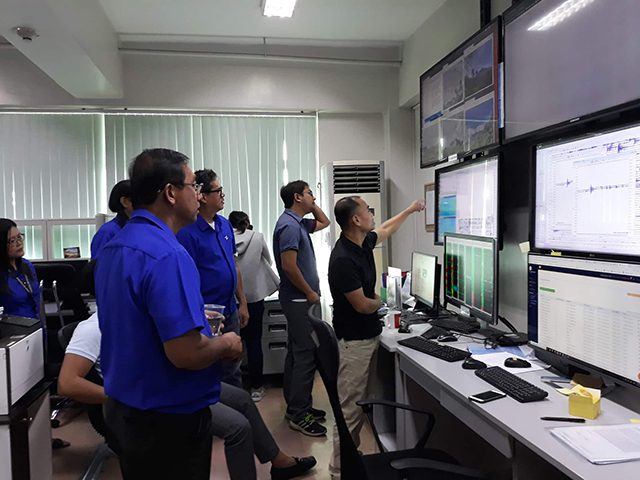A Cavite lawmaker still sought to probe the Philippine Institute of Volcanology and Seismology’s failure to inform the public even if the agency had been providing updates of Taal Volcano’s situation through its social accounts and its website.
Cavite was among the hardest hit provinces by the heavy and toxic ashfall spewed by the eruption of Taal Volcano.
In House Resolution 643 he authored, Rep. Elpidio Barzaga Jr. of Cavite questioned the agency’s lack of announcements when the volcano was placed at Alert Level 1 last March 2019, which should have better prepared them for the calamity.
“Although it stated there was a warning of Level 1 since March 2019, there is clearly a lack of dissemination of information,” Barzaga said.
He said PHIVOLCS did not disseminate information when the volcano manifested increased activity in the morning of January 12.
Taal volcano was only at Alert Level 1 that time. It suddenly raised the alert level to 2 at 2:30 p.m. then raised it again to alert level 3 at 4 p.m.
By 7:30 pm, PHIVOLCS raised it to the current alert level 4.
“Due to lack of information, in the afternoon of the same day, while Taal Volcano is already manifesting increased volcanic activity, people still traveled towards it, while those who were already near the Taal volcano were shocked to see the smoke spewing from it and had to immediately flee under the dangers of ashfall,” part of the resolution read.
Several Filipinos defended the state-run monitoring agency, citing the difficulty in predicting volcanic eruptions.
“Eruptions are rarely predictable—if not unpredictable—and Phivolcs can only issue warnings based on current seismic activity. Government agencies at this point should focus on relief and rescue operations and preparing for the hazardous eruption being warned by Phivolcs,” Philip Jamilla of Karapatan said.
Eruptions are rarely predictable—if not unpredictable—and Phivolcs can only issue warnings based on current seismic activity. Government agencies at this point should focus on relief and rescue operations and preparing for the hazardous eruption being warned by Phivolcs.
— Philip Jamilla (@pmjamilla) January 14, 2020
Another Twitter user noted the bad timing of the investigation.
“We’re facing an imminent explosive eruption and the least we can do is to support them and follow what they’re saying,” Twitter user @AbainzaRalph said.
I am strongly against the call for investigation na sinusulong ng congress against PHIVOLCS. Kasagsagan ng eruption ididistract niyo sila?
We're facing an imminent explosive eruption and the least we can do is to support them and follow what they're saying.
— Ralph Abainza (@AbainzaRalph) January 14, 2020
Volcano monitoring
PHIVOLCS had been monitoring and regularly posting updates of seismic activities even before the eruption last January 12 through its social accounts and news bulletins on its website.
It issued a news bulletin when Taal Volcano was initially placed under alert level 1, which means no hazardous eruption is imminent, in March of 2019.
When it posted a high number of volcanic-induced tremors in December of that year, it was immediately picked up by local mainstream media and some online outfits.
On January 14, PHIVOLCS also shared an infographic of its monitoring findings on three volcanoes—Taal volcano, Mayon volcano and Bulusan volcano.
“Para sa inyong kaalaman, ang DOST-PHIVOLCS ay nagbabantay 24 oras sa mga aktibong bulkan sa bansa,” it said in the caption.
Para sa inyong kaalaman, ang DOST-PHIVOLCS ay nagbabantay 24 oras sa mga aktibong bulkan sa bansa. Para sa daily updates…
Posted by Philippine Institute of Volcanology and Seismology (PHIVOLCS-DOST) on Monday, January 13, 2020
How unpredictable are volcanic eruptions?
According to Popular Science, determining the exact time and scale of the eruption is still impossible despite the breakthroughs in technology.
“Unlike weather patterns, which tend to occur literally in the open air, the factors that lead to a volcanic eruption unfold deep inside our planet, further down than current technology can reach. So we rely on indirect observations instead,” the article said.
Volcanoes provide warning signs, the United States Geological Survey said, before an eruption. These precursors are:
- An increase in the frequency and intensity of felt earthquakes
- Noticeable steaming or fumarolic activity and new or enlarged areas of hot ground
- Subtle swelling of the ground surface
- Small changes in heat flow
- Changes in the composition or relative abundances of fumarolic gases
Taal volcano, in particular, underwent several changes since its last eruption in 1977.
“Every eruption is different. There’s nothing guaranteed,” Ed Venzke of the Smithsonian Institute said to National Geographic.










